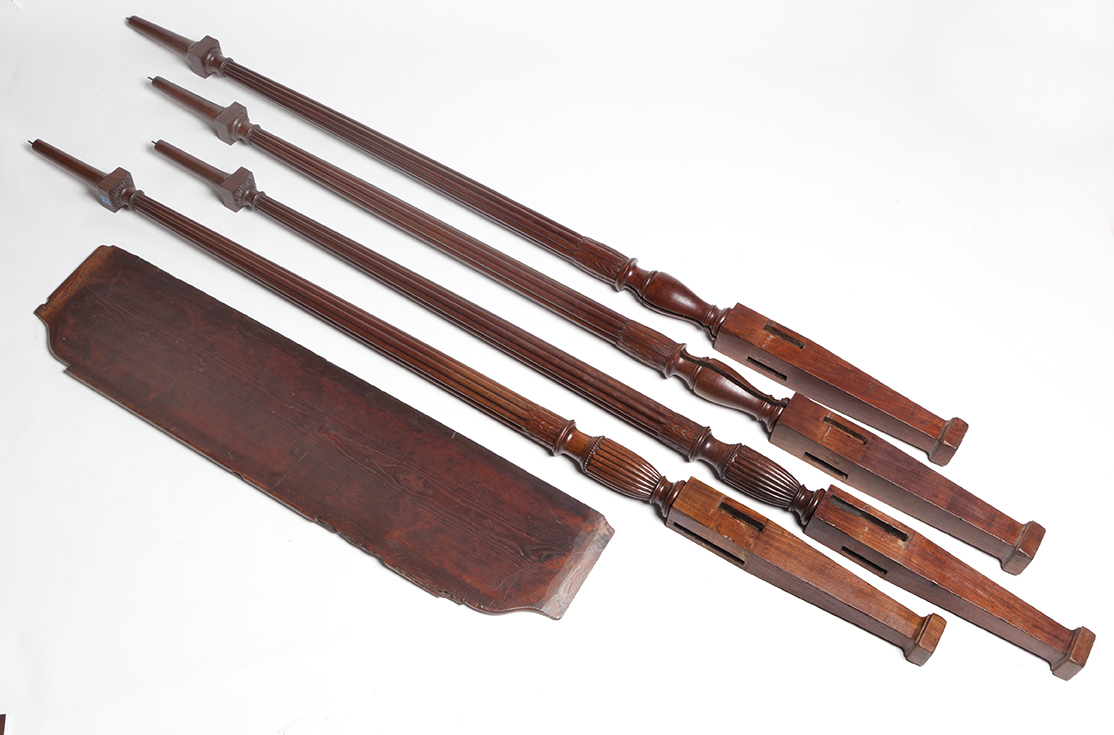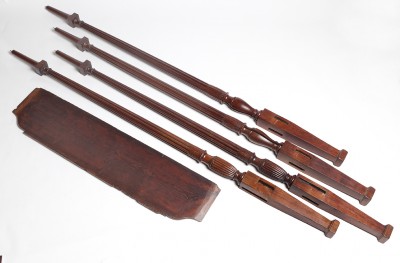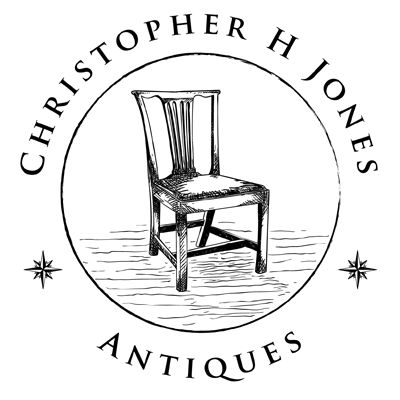Mahogany Bed with Four Carved “Pillars”
Finely Rendered Urns and Fluted Posts
Descended in the Payne/Scott Family of “Scotia”
Fredericksburg, Virginia
Circa 1790-1800
Commentary: Scotia, the Fredericksburg, Virginia home of John Scott 1848 and Frances Susannah Stone Payne (1780-1867), was built in the last years of the 18th century, by family tradition as a wedding present. It was a large, four chimneyed frame house of two plus stories situated on Charles Street opposite the law office of James Monroe. Scotia survived the devastation that the Civil Way wrought upon Fredericksburg but not the 20th century urge to modernize and was demolished in the 1920s. This bed is one of a number of notable items of furniture that descended from the marriage of John and Frances, including a corner chair (Private Collection, MESDA File 5964) and mahogany dining table (Private Collection) that are indicative of the high quality of furniture the Scotts obtained from local cabinet makers.
John Scott was born in 1772 in Greencock, Scotland. In 1788 he came to Virginia and landed at Leedstown. Dora Jett’s book on Fredericksburg, “Minor Sketches of Major Folk”, states that Mr. Scott then crossed over to Essex and found employment with the Brookes of Brooke’s Bank, who had built a large tobacco shipping trade. He later moved to Fredericksburg and entered a business partnership with his fellow Scotsman Robert Mackey. Frances was a daughter of Captain William Payne and his first wife Susannah Richards. The Scotts were married on the 14th of October 1798 in Fredericksburg. Together they would have 12 children. John Scott made Fredericksburg the base of his business endeavors throughout his career and died there January 11, 1848 at “Scotia”. His tombstone reads in part – “Long one of the most respected merchants in Fredericksburg.” His wife, known in her later years as “Aunt Scott”, survived the tumultuous years of the Civil War in Fredericksburg dying there in 1867. This bed was acquired from a direct descendent in 2013.
In his Cabinet – Maker and Upholsterer’s Guide, George Hepplewhite provided eight different designs for “Bed Pillars” including four with “Term Feet” after which this bed is patterned (Page 21 & Plate 106). It has not yet been possible to link the bed or its carver to a particular shop although cabinet makers in Williamsburg, Fredericksburg and Alexandria were well acquainted with the style and quite capable of executing the design. By way of example, Alexandria’s most prominent cabinetmaker during this period John Mur recorded in his account books numerous examples of “mahogany bedstead [s], the food Posts reeded and fluited” or “a high Posts & bedstade the foot posts reeded and fluited.” Muir also recorded frequent charges for putting up, taking down or repairing such beds and their hangings for his Alexandria clients. The Colonial Williamsburg collection includes a similar bed that descended in the Galt Family.
Condition: The four posts of Cuban Mahogany survive in excellent condition along with the original tester frame. As was the norm, the posts at the foot of the bed were fully carved while the headboard posts were only carved in the areas in which they would have been visible when the full complement of textile hangings were in place. The lower connecting rails have been modified, probably several times, to accommodate slates. The headboard, which would have been obscured by the textile hangings, is of “mahoganized” yellow pine and may be original but could be a 19th century replacement.
Price:sold



